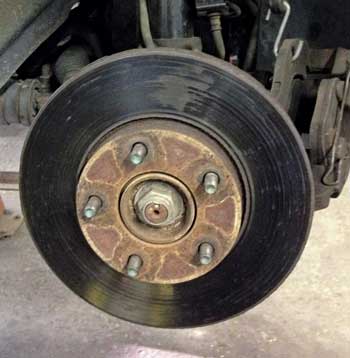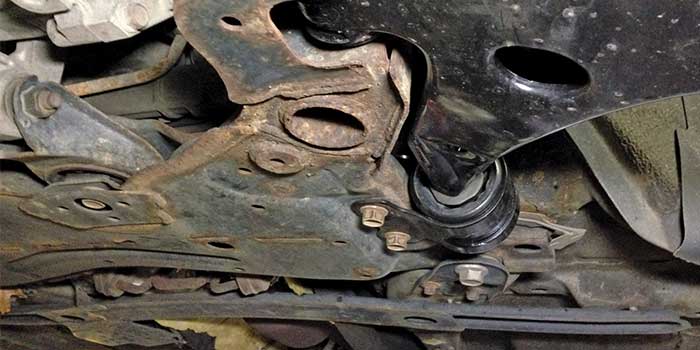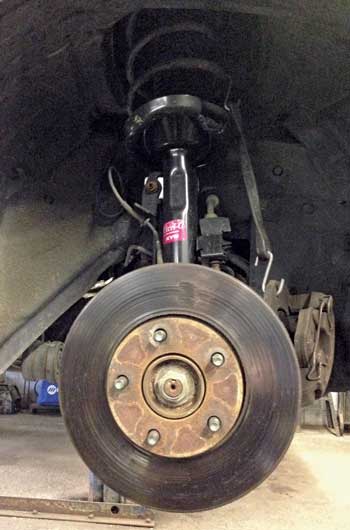Undercar Maintenance
Adapted from Bob Dowie’s article in ImportCar.

Let’s take a look at brake and undercar service on the Mazda vehicle lineup, with the footnote that even though this type of work becomes routine when you have a preventive maintenance mindset, good work habits from beginning to end are critical for a successful job that ensures customer satisfaction.
Every job should start with the customer interview, and a good first question to ask is why the customer thinks the car needs to be serviced.
The next step in any undercar diagnosis should be a test drive. That way, you can confirm the customer’s complaint and also note any other issues with the car that should be addressed.
Brake and suspension problems will surface in a couple of ways, the most common of which are noise-related. The suspension noise will generally be a knocking sound as the car is driven over bumps, or a noise when the steering wheel is turned. With the brakes, you’ll be hearing noise issues that range from an occasional squeak to a constant grinding noise.
Mazdas, like many other import nameplates, make use of the simple and effective tab-type sensor that will contact the rotor when the pads need to be replaced. Some noise will also be the result of rust on the rotors, calipers, hardware or even the brake pads themselves. Use only the best parts, replace questionable units and make sure that the brake hardware is in good condition or new.
This is particularly important with Mazda3s and 6s that have some problems with the hardware contacting the rotors. There have been some technical service bulletins (TSBs) related to this issue, so be sure to check your service information system. Also make sure that all the metal-to-metal contact areas are lubed with the proper grease that’s designed to do this tough job in a harsh environment.
On the Mazda 3s, wheel-bearing failures are also fairly common. The noise comes on gradually and is often overlooked by the customer. If you have the brakes apart, this is a good time to check the wheel bearings, as well as inspect the sway bar links. In addition, you should also be looking for rotor vibration, a long pedal, or pulling or drifting issues that could be related to the brake system, but may also be a steering or suspension problem.
With the vehicle back at the shop and on the lift, your inspection should continue. Spin and shake the wheels before they come off, noting any excessive drag or noise. And, it goes without saying that any looseness in the steering components should be investigated and reported as a safety concern. Look at the control arm bushings; movement there can cause a variety of problems from tire wear to noises to a pull under braking. Also take the time to inspect and confirm there are no broken springs.
BRAKE ISSUES
With the wheels off, inspect the pads and rotors, looking for signs of overheating or uneven wear. Leaking calipers or wheel cylinders always leave visual evidence. Also inspect the brake hoses – if they need to be replaced, now is the time to do it.
Be sure to open the bleeder valves before the pistons are pushed back into the caliper. With most cars today being equipped with ABS, there is little tolerance for contaminated fluid being pushed back through the system and to that sensitive modulator unit. You’re going to be bleeding and flushing the system as part of the service, so there is no time lost in this step. And, if the bleeder can’t be opened or needs to be cleaned, it’s better to find out now rather than after the caliper has been serviced and new pads are installed.
The most common brake-related vibration occurs during braking and is caused by damaged rotors. With our shop being in the rust belt, rotors are replaced more often than not to prevent noise and ensure a quality job.
This leads us to more discussion on work habits. Be certain that all the areas where pad movement takes place are cleaned and lubed. Also be sure the caliper slides are inspected, clean and lubed. This is important not only for smooth, quiet brake operation, but it’s critical for the ABS to operate as expected.
In extreme wear cases, you may find it more cost effective to replace the calipers, rather than spending the time required to service the originals.
With high-mileage vehicles, you could be faced with a “brake pedal sometimes fades to the floor” complaint, which requires a little detective work in some cases. If the pedal fades in a situation where the pedal is being partially applied in anticipation of coming to a full stop, it’s a safe bet the master cylinder is the culprit.
If, on the other hand, the condition results after a long ride at highway speeds, it’s likely that excessive drag is causing the fluid in the calipers to overheat, resulting in brake fade. When the brakes cool, the pedal often will return to what feels like normal to the customer. Many times, the customer will report a burning smell and, in the worst cases, a severe vibration. It takes a stuck caliper to generate the degree of heat needed to cause these problems, so they certainly should be checked closely.
You should be able to find the problem wheels by inspecting the rotors. If that much heat was generated, it will be evident in both the calipers and the rotors. Don’t be too quick to condemn the caliper without cracking open the bleeder to be sure there’s no pressure in the line. If pressure exists, backtrack through the hydraulic system until the restriction is found. It could be a collapsed brake hose acting as a one-way valve, or you may work your way back to a contaminated ABS modulator. It’s always a good practice to replace any brake hose that was subjected to extreme heat. While it may look OK and not leak, there is no way to know if the integrity of the crimps was comprised, and for a few extra dollars it’s better to be safe than sorry.
Finish off with a good bleed and flush of the hydraulic system, torque the wheels and the car should give the customer many miles of trouble-free braking.
As I mentioned earlier, we’ve been seeing some wheel bearing failures on the popular Mazda3 models. It’s important to keep in mind that the bearings are directional and have to be installed with the internal tone ring facing the ABS sensor. Most bearings are color-coded with the green seal being installed toward the sensor. Since the tone ring is magnetic, you can confirm the proper direction by laying a light piece of steel against the seal (we use a 6” rule).

CHASSIS REPAIRS
The nuts and bolts of suspension and steering service shouldn’t present any service problems, but there are a couple of things you can do to make the job go smoothly. Whenever you remove a bolt that goes through a bushing, confirm that the bolt isn’t seized. This lets you include the extra time required on the schedule and estimate, but, more importantly, it will allow you to source any special hardware to complete the job.
When replacing sway bar links, it may be easier to use a pry bar and separate the end links so you can hold the ball end of the joint as the nuts are removed. Other than that, the only tip I can offer is to use some patience. It’s always better to spend some time to remove rusted bolts rather than break them. A couple of broken bolts can turn a simple sway bar bushing replacement into a project.

NEW TECHNOLOGY
Mazda has adopted an electrohydraulic power-assisted steering (EHPAS) system. An electric pump replaces the former belt-driven pump, freeing up space and, more importantly, saving fuel by eliminating drag. This system uses a control module to make pressure decisions based off various sensors, which is one more reason you need an enhanced scanner. The system has been reliable with most issues being the result of accident damage. In the event you have a pump issue, the pump itself can be replaced using the old module that will eliminate the need for reprogramming. As always, be sure to refer to your service info when servicing a system that’s new to you.
Brake Energy Regeneration System: The gas savings don’t end with steering. Mazda has developed a system that’s called intelligent energy loop or i-ELOOP. It uses regenerative braking to quick-charge a capacitor that then runs various electrical components, taking some of the load off the belt-driven alternator. It can be used to power the headlights, climate control, audio system or any other electrical equipment.
This reduces the need for the engine to burn extra fuel in order to generate electricity and, thereby, improves fuel economy. The capacitor gets charged at 25V by the regenerative system or the alternator, if needed, and a step-down convertor is used before distribution to the components. It will be a few years before shops start to see these cars, but it’s interesting technology and a sign of things to come. A quick internet search of Mazda i-ELOOP will give you more details.













